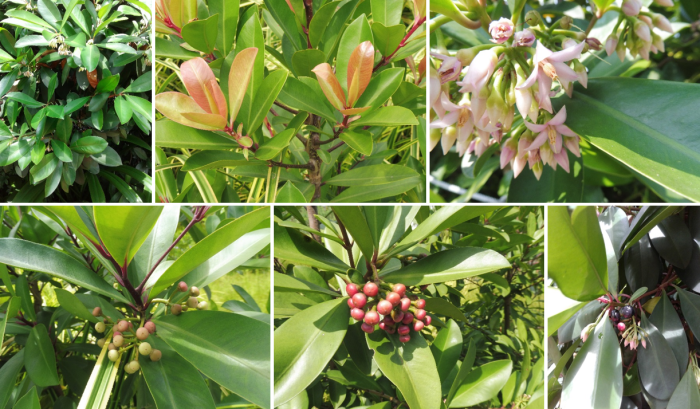The funny thing about landscaping is that plants often end up growing where they otherwise wouldn’t. Such as this seashore ardisia (Ardisia elliptica), which despite being a coastal plant by nature, certainly wasn’t remotely near any shoreline when I walked past it.

Flowers
But it looked to be growing fine, putting forth its clusters of pink star-shaped flowers and shiny round fruits, which are drupes, ripening from reddish-purple to black, with pulp that can stain fingers and one spherical seed per fruit. The ripe fruits have earned it names such as shoebutton ardisia, mata pelandok (‘eye of the mousedeer’ in Malay), and mata itek (‘eye of the duck’ in Malay). The plant is native to India and across to Southeast China and Southeast Asia. It prefers tropical climates, and if left to its own devices is found in coastal forests and along shorelines, attaining heights of 5-8m. Leaves are elliptic, leathery, and alternate, tinged with pink when young. Seashore ardisia reproduces readily from seed, and can tolerate shade well, factors which have allowed it to proliferate well enough to be considered an invasive weed outside its native range.

Fruits in the process of ripening
The plant serves as a host plant for the Malayan plum Judy butterfly, the dark Ceylon six-lineblue butterfly, and a number of moths. As for humans, the young shoots of the plant are edible, either raw or cooked. In Southeast Asia, decoctions of the roots and leaves are used to treat heart pains, and the leaves are also used to treat scabies, herpes, and measles. The fruits are used against diarrhoea and intestinal worms, rather than being eaten for leisure.

Seashore ardisia (Ardisia elliptica)
Mostly though, it’s planted as an ornamental for its colourful foliage, pretty flowers, and shiny fruits. And if diarrhoea strikes when one least expects it, I suppose grabbing a bunch of berries by the road might be a solution of sorts. Well, till the doctor finds out that one self-medicated with an unknown dose of rumoured traditional medicine, at least.
References
- http://www.sms.si.edu/irlspec/ardisia_elliptica.htm
- http://www.wildsingapore.com/wildfacts/plants/coastal/ardisia/elliptica.htm
- https://en.wikipedia.org/wiki/Ardisia_elliptica
- https://florafaunaweb.nparks.gov.sg/Special-Pages/plant-detail.aspx?id=2727
- https://lkcnhm.nus.edu.sg/dna/organisms/details/27


